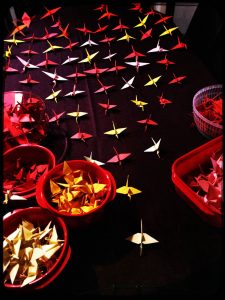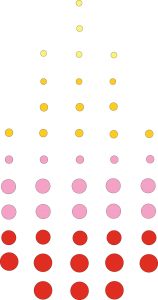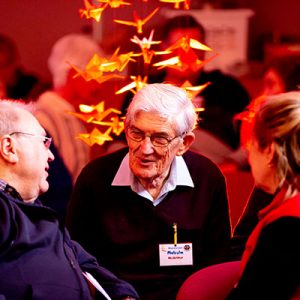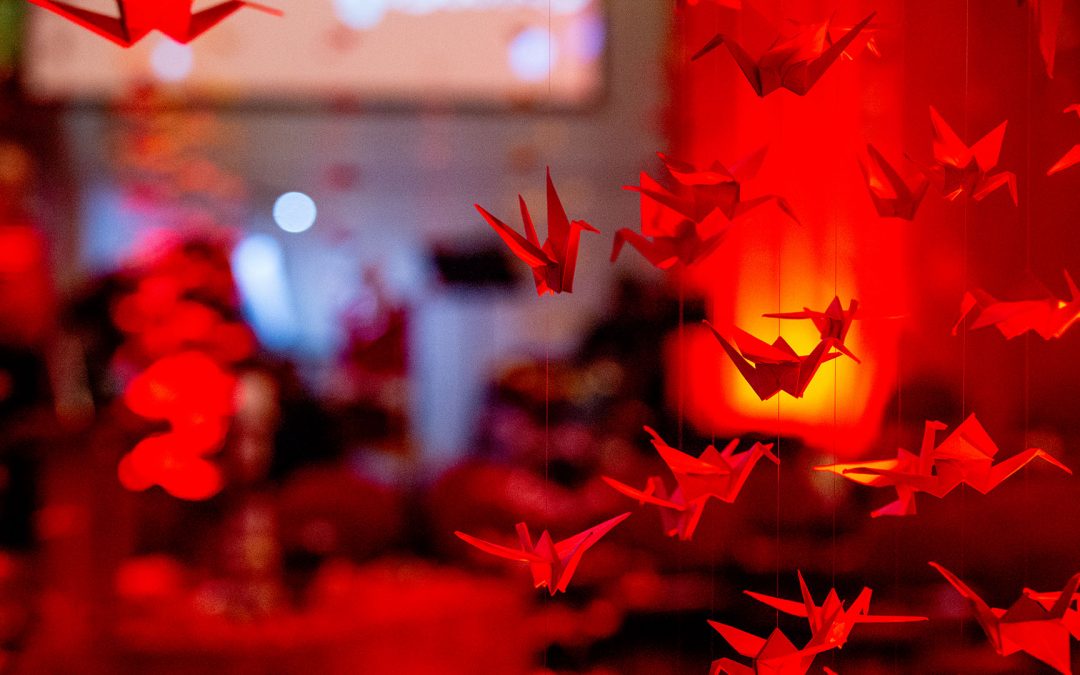Here’s a repost from my old blog of the wonderful Pentecost celebration at Blackwood UC in 2018. This is referenced in my book Deeper Water.
Last year’s Pentecost Service involved the congregation in making and hanging about 1200 paper birds (representing the Holy Spirit) in the sanctuary. The birds were in various shades of red, orange and yellow to symbolise flames as well. Over several weeks we held origami sessions at morning tea between the two services. I discovered two origami whizzes in the congregation who were delighted to help teach (and each make many, many cranes). The cranes were in several different sizes, and people took home pieces of paper of their choice (the smaller ones being more difficult to make). We DID receive back some renegade colours and sizes, some of which I discreetly forgot to use. (And no matter how many times I told people how to fold the wings…. sigh.) However the participation of many people in making cranes was a vital dimension of the whole experience. It was a shared community activity.
I designed a hanging mobile of cranes. The idea was that several of these would be hung from the ceiling fans (controls gaffer-taped OFF!) so that the bird flames would be falling or rising down/up into the congregation. The remaining birds would be strung on fishing line at intervals across the room. With two data projectors at different angles there were a number of sight line issues to resolve.
 The mobile frames were circles of plastic mesh from Bunnings about 50cm diameter with a dowel crosspiece, spray painted white (sorry, no separate photo). Each had 9 lines of cranes on fishing line at measured intervals with a colour pattern, attached to the frame with fishing swivels and catches. Here they are being sorted and laid out on our dining room table, pattern in development.
The mobile frames were circles of plastic mesh from Bunnings about 50cm diameter with a dowel crosspiece, spray painted white (sorry, no separate photo). Each had 9 lines of cranes on fishing line at measured intervals with a colour pattern, attached to the frame with fishing swivels and catches. Here they are being sorted and laid out on our dining room table, pattern in development.
This is the part that nearly broke us… Tying the crane strings for the mobiles was the MOST time-consuming and fiddly. The cranes had to be threaded onto the line with a knot so they would not slide or turn upside-down. The intervals had to be measured so that the whole mobile would have symmetry. 6 hoops x 9 strings x 76 cranes. We made a lot at home but I asked some people from the church to help. From the diagram you will see the size and colour variation of the cranes, which we hadn’t really planned when I asked people to just start making them. In the end we had oversupply and undersupply in different sizes and shapes and wwre making extra cranes though we had cranes everywhere. (yes I compromised on the colours a little).
Did I mention FISHING LINE TANGLES!!! We had a prototype hanging in our lounge room and cranes EVERYWHERE!
Some of the volunteers were better than others at the stringing, which caused some repair work at the end prior to hanging.
 There was a version of this document with hand written measurements, but it is lost in time. So – one centre hanging line, then four – each from the mid-point of one of the cross pieces, then four – offset from the cross-pieces hanging from the outer plastic ring. Each string was bagged separately in a plastic bag for transport and later assembly at the church.
There was a version of this document with hand written measurements, but it is lost in time. So – one centre hanging line, then four – each from the mid-point of one of the cross pieces, then four – offset from the cross-pieces hanging from the outer plastic ring. Each string was bagged separately in a plastic bag for transport and later assembly at the church.
We needed to suspend each frame, then clip on the 9 lines of birds without tangling them, and then carefully raise each one up into position. Peter Cranwell and Tim Lee were amazing co-conspirators, along with Russell Greer who is always behind the scenes at Blackwood. Tim provided fantastic lighting courtesy of his son, including a couple of shifting flames on the walls. I used a couple of my battery-powered LED mini-panels as uplights on the mobiles at each end of the communion table.
 Tim also made a 3D animation of falling cranes that we used to precede the service. I just love it when a creative event brings people’s talents out of the woodwork. “Would you like a 3D animation with that? Sure!” The music accompanying the movie was “Song for Jesse” by Nick Cave and Warren Ellis from the soundtrack “The Assassination of Jesse James by the Coward Robert Ford” (2 mins 38 secs)
Tim also made a 3D animation of falling cranes that we used to precede the service. I just love it when a creative event brings people’s talents out of the woodwork. “Would you like a 3D animation with that? Sure!” The music accompanying the movie was “Song for Jesse” by Nick Cave and Warren Ellis from the soundtrack “The Assassination of Jesse James by the Coward Robert Ford” (2 mins 38 secs)
So what about the worship itself? The worship was kept pretty simple, with colour imagery throughout. Keep it dynamic, not over-wordy. Let the symbols speak. We set the room lighting dim so that the lighting of the cranes and mood lighting was vivid. There were audible gasps as people entered. People were spell-bound. The birds, of course, moved with and movement of air, floating breath. We did the Acts 2 reading with a narrator, and then I walked around the room doing Peter's speech to the crowd. I also lit the fire in the bowl at the start of the Bible reading (the metho and clay kitty litter trick). I told the Grasshopper on the Road story “A Voyage”.
 I decided that the sermon needed to be the voice of the Spirit pouring out dreams and visions upon the people. We invited six people to share briefly something of what the Spirit was saying to us as a church. I then invited members of the congregation to share in groups of three what the Spirit was saying to them. This wasn’t a lame invitation, but a declaration that the Spirit speaks to us today through one another. The buzz was amazing. Afterwards I roamed the congregation with a roving mic inviting a number of people to share a sentence.
I decided that the sermon needed to be the voice of the Spirit pouring out dreams and visions upon the people. We invited six people to share briefly something of what the Spirit was saying to us as a church. I then invited members of the congregation to share in groups of three what the Spirit was saying to them. This wasn’t a lame invitation, but a declaration that the Spirit speaks to us today through one another. The buzz was amazing. Afterwards I roamed the congregation with a roving mic inviting a number of people to share a sentence.
Call to Worship by Roddy Hamilton, prose by Kate Compston and a prayer adapted from Jon Humphries.
Songs: Where the Spirit Is, There is Freedom; Dreams and Visions; Cry Out for Love (which of course mentions 1000 raucous cockatoos); and Filled with the Spirit’s Power. There were plenty of cranes around the room, and people were invited to take one if they chose as a reminder and promise. I have to say that for the congregation this was a great experience, not only of symbolism but of participation. A very special time. People didn’t want to leave the room. Loads of appreciative feedback.
First up, people didn’t want the cranes taken down, so they stayed up for six weeks. The following Sunday was Reconciliation Sunday, and the visiting Aboriginal folks thought it was wonderful. I talked a lot about Spirit that day. Groups using the church on a regular basis, including the yoga group and the community choir, gave warm and appreciative comments. A choir member said they were standing near one of the hanging pieces, and when they sang, their breath moved the birds.
 The afternoon light through the stained glass windows happened to light the birds quite beautifully. During the week, people kept coming into the sanctuary to show friends or just to have a look. It became a space filled with symbol rather than the usual empty carpet with chairs stacked away. This spoke volumes to me about church as cathedral/sacred-art space, and leaders chatted about how we could craft empty space to be sacred space. Much more could be said.
The afternoon light through the stained glass windows happened to light the birds quite beautifully. During the week, people kept coming into the sanctuary to show friends or just to have a look. It became a space filled with symbol rather than the usual empty carpet with chairs stacked away. This spoke volumes to me about church as cathedral/sacred-art space, and leaders chatted about how we could craft empty space to be sacred space. Much more could be said.
What do you do with 1000 paper cranes? Put them in the bin?
We took the cranes down, then someone wanted to re-hang some of them for a Taize service a couple of months later. Another person who volunteered with Red Cross borrowed a bunch for their Hiroshima Day commemoration. At some point during that time, I was chatting to long-time friends in Japan, Russell and Anita. Anita is a teacher. Her international school takes students from to Hiroshima each January. And so a plan to send the birds to Japan was hatched. The birds were painstakingly removed from the fishing line and sent in a large postbag to Tokyo. The postbag was displayed in worship and made a part of our prayers for the world. Postage $60.
The students threaded our cranes and theirs together to hang at the Peace Park. I was asked to write a statement suitable for their non-sectarian school explaining where the cranes had come from and their significance. I wrote this:
These paper cranes were made by the people of Blackwood Uniting Church in Adelaide, South Australia in 2018. They have asked us to say these words here at the Peace Park.
For us, the bird is a symbol of the Spirit
– the Spirit who brings peace, harmony and hope,
– the Spirit who unites people across barriers
of race, class, politics, age, gender and nationality.
Each year we celebrate the coming of this Spirit on the day of Pentecost,
a day that for us represents peace as a gift to be received and cherished.
We mourn the unnecessary damage and death caused by war.
We remember those who have suffered and those who continue to suffer in our world.
We send and offer these cranes as a sign and prayer for peace in our world
– for understanding and tolerance of differences
– for forgiveness and mercy where there was been hatred
– for healing where there was been pain and hurt
– for trust where there has been suspicion and fear
– for generosity where there has been self-centredness
– for unity where there has been division
– for hope where there has been despair.
This is our prayer today.
In January we received photos and video from Anita of the presentation in Hirsohima. I put together a short video which was shown during worship in February (It can’t be shared wider because of the privacy of the school students) and together we said an adapted version of the above as a prayer. I must say that people were deeply moved by the video. Smiles, nods, tears. These tiny pieces of paper that we had folded with our own hands became a tangible prayer for the peace the the Spirit brings as gift and promise.

